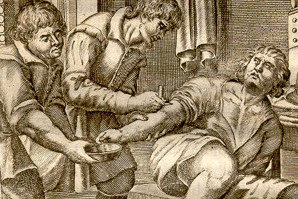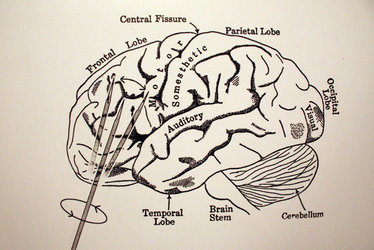Cures
Centuries ago insanity was believed to be developed through religion. Many thought that either God or more commonly the Devil, evil spirits, or darkness was overcoming someone’s mind and body. For many years the dwelling of insanity was said to be found inside the brain. This idea, formulated by Hippocrates, states, “through this organ we learn and comprehend; and it is through the same organ we become insane” 21. Most individuals who were mentally ill did not receive treatment and were sheltered in the homes of their families or were homeless. Those who did receive treatment might have been “cured” by the following remedies.

Sedation was a form of treatment given to patients to calm their emotions or sooth pain. Opium was one very popular sedative. It was administered in its pure form and in syrup form. The drug was rationed 18-60 drops, or 2-8 grains per day, until temporary calmness was obtained. It was later found that extensive doses of opium also cause insanity.
Bloodletting was a form of sedation and a way to release negative energy from the body. It was thought that if “bad blood” was released from the body it would help an individual regain their sanity. A physician forced the depletion of blood from the body of the person who was mentally ill. They would perform phlebotomies, which is when a vein is carefully selected, then punctured with a needle and the blood is drawn off. These procedures were performed on the upper cavity of the body, mainly the jugular veins and temporal arteries. It was thought that venous blood (lacking oxygen) was stored in this area and once it was released the person would feel relief. Sometimes the artificial blood-letting was continued until the person fainted 23. Bloodletting is still practiced today around the world using leeches.
Purging has the similar idea of bloodletting and sedation, but different procedures are used. The idea was that excretion of bodily waste and fluids would cleanse out impurities. There were many ways purging was performed. One, was to ingest Hellebore, flower with poisonous properties that once ingested caused patients to vomit.

Many of the patients in asylums were tortured because the physicians didn’t know how to interact with them and vice versa. Patients and inmates were beat with rope and chain, as well as whipped. It was frequent that a person with dementia or manic behaviors was detained in solitude. Other times they were put in restraints such as chains, leather straps and double leather straps with a metal plate, and straight jackets. Patients were left in these conditions for extended amounts of time without human interaction. Some were left in restraints for so long that the open wounds from the tightness and resistance to the restraint developed gangrene.

Since many physicians believed that illness was found in the brain they tried to experiment on the organ directly. Phrenology is the only practice that didn’t require drilling into or prodding within the skull. This idea of Phrenology is that one could determine mental and physical issues depending on swelling, and differences of size of lobes in the brain. To determine if one had a mental issue the physician would take extensive measurements of the head, and label sections of the brain to decide if swelling or abnormal size was causing their symptoms. Trephination was a practice where a physician created a hole in the skull of the patient to release pressure. The idea was that once the hole was created all negative energy and pressure in the brain would be released, curing the patient of their mental disorders. Lobotomy is similar to trephination in that the brain is being experimented on directly, yet this procedure involves cutting into the tissue itself. A doctor inserts a probe through the front of the skull or eyes and scrapes away the connections between the prefrontal cortex and the frontal lobes of the brain. These areas of the brain are associated with personality, expression, and decision making. After a lobotomy patients were indeed calmer, but were left with a flat affect among other negative side effects. Both trepanation and lobotomies were performed while the patient was awake, which is still common today in modern medicine when a doctor is working on the brain. Lastly, electroconvulsive therapy or electric shock was used. A machine was hooked up to an individual and they receive small burst of electricity to induce seizures. The electricity in the body disrupts the flow of energy and essentially jump starts the brain. This practice was used two to three times a week and was very painful. It was later found that extensive electroshock therapy can result in short and long term memory loss.
A very dangerous, but frequently used way to rid of mania was to submerge the patient under water for long periods of time until signs of asphyxia were seen. “Every idea is destroyed in a man almost dead under water” 25. Once revived from near death the individual cannot recall anything more vividly that his near death experience 24 This practice was thought to scare the negative energy out of ones body and replace it with a newfound appreciation of life.